Naming organic compounds Study guides, Revision notes & Summaries
Looking for the best study guides, study notes and summaries about Naming organic compounds? On this page you'll find 256 study documents about Naming organic compounds.
Page 4 out of 256 results
Sort by
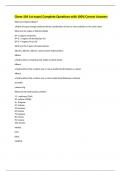
-
Chem 104 1st exam|Complete Questions with 100% Correct Answers
- Exam (elaborations) • 24 pages • 2024
-
- £10.90
- + learn more
Chem 104 1st exam|Complete Questions with 100% Correct Answers What are hybrid orbitals? orbitals of equal energy produced by the combination of two or more orbitals on the same atom What are the types of hybrid orbitals SP- 2 regions of density SP^2- 3 regions of density(3sp^2s) SP^3- 4 regions (4 sp^3s) What are the 4 types of hydrocarbons alkanes, alkenes, alkynes, and aromatic hydrocarbons Alkane a hydrocarbon containing only single covalent bonds Alkene a hydrocarbon that contai...
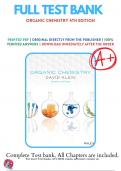
-
Test Bank for Organic Chemistry 4th Edition by David R. Klein | 9781119659594 |2021-2022 |Chapter 1-27 | All Chapters with Answers and Rationals
- Exam (elaborations) • 2151 pages • 2023
-
- £34.71
- + learn more
Test Bank for Organic Chemistry 4e 4th Edition by David R. Klein. ISBN-13: 9594 Full chapters test bank PDF TABLE OF CONTENTS 1 A Review of General Chemistry: Electrons, Bonds, and Molecular Properties 1 1.1 Introduction to Organic Chemistry 2 1.2 The Structural Theory of Matter 3 1.3 Electrons, Bonds, and Lewis Structures 4 1.4 Identifying Formal Charges 7 1.5 Induction and Polar Covalent Bonds 8 1.6 Reading Bond-Line Structures 11 1.7 Atomic Orbitals 14 1.8 Valence Bond Theory 17 1.9 Molecular...
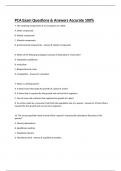
-
PCA Exam Questions & Answers Accurate 100%
- Exam (elaborations) • 18 pages • 2023
- Available in package deal
-
- £10.49
- + learn more
7. The nonliving components of an ecosystem are called: A. Biotic compounds B. Abiotic compounds C. Mineral components D. Environmental components - Answer B. Abiotic compounds 8. Which of the following ecological concepts is illustrated in a food web? A. Population equilibrium B. mutualism C. Biogeochemical cycles D. Competition - Answer B. mutualism 9. What is a limiting factor? A. A biotic factor that stops the growth of a plant of animal B. A factor that is required for t...
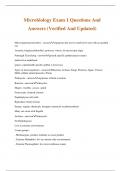
-
Microbiology Exam 1 Questions And Answers (Verified And Updated)
- Exam (elaborations) • 9 pages • 2024
-
- £9.28
- + learn more
Microbiology Exam 1 Questions And Answers (Verified And Updated) Microorganisms(microbes) - answerorganisms that are too small to be seen with an unaided eye -bacteria, fungi(yeast&molds), protozoa, viruses, & microscopic algae Naming& Classifying - answergenus& specific epithet(species name) italicized or underlined genus= capitalized& specific epithet is lowercase Types of microorganisms - answerBacteria, Archaea, Fungi, Protozoa, Algae, Viruses, Multi-cellular animal parasites, Prion...
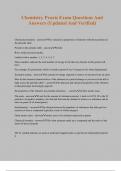
-
Chemistry Praxis Exam Questions And Answers (Updated And Verified)
- Exam (elaborations) • 7 pages • 2024
-
- £9.28
- + learn more
Chemistry Praxis Exam Questions And Answers (Updated And Verified) Chemical periodicity - answerThe variation in properties of elements with their positions in the periodic table Periods in the periodic table - answerPeriods: Rows which run horizontally. Labeled with a number: 1, 2, 3, 4, 5, 6, 7. These numbers indicate the total number of energy levels that any element in this period will have. For example, K (potassium) which is found in period 4, has 4 energy levels when diagrammed. ...
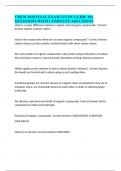
-
CHEM 1020 FINAL EXAM STUDY GUIDE 184 QUESTIONS WITH COMPLETE SOLUTIONS
- Exam (elaborations) • 21 pages • 2023
-
- £8.88
- + learn more
CHEM 1020 FINAL EXAM STUDY GUIDE 184 QUESTIONS WITH COMPLETE SOLUTIONS what is a major difference between organic and inorganic compounds? -Correct Answer organic contain carbon what is the reason why there are so many organic compounds? -Correct Answer carbon atoms can form stable covalent bonds with other carbon atoms the vast number of organic compounds is due to the unique chemistry of carbon. this chemistry involves -Correct Answer formation of long chains& isomerism Which applies...
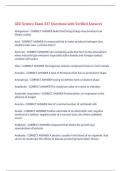
-
GED Science Exam 337 Questions with Verified Answers,100% CORRECT
- Exam (elaborations) • 27 pages • 2023
- Available in package deal
-
- £10.49
- + learn more
GED Science Exam 337 Questions with Verified Answers Abiogenesis - CORRECT ANSWER Belief that livings things may develop from lifeless matter Acid - CORRECT ANSWER A compound that In water produces hydrogen ions, usually tastes sour, a pH less than 7 Acid rain - CORRECT ANSWER rain containing acids that form in the atmosphere when industrial gas emissions (especially sulfur dioxide and nitrogen oxides) combine with water Alloy - CORRECT ANSWER Homogenous mixture composed of two or mo...
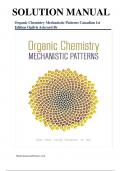
-
Solution Manual for Organic Chemistry Mechanistic Patterns Canadian 1st Edition by Ogilvie Ackroyd Br
- Exam (elaborations) • 811 pages • 2024
-
- £16.14
- + learn more
Chapter 1 Carbon and Its Compounds CHECKPOINT PROBLEMS Practice Problem 1.1 a) S — 1s2 2s2 2p6 3s2 3p4 b) Cl — 1s2 2s2 2p6 3s2 3p5 c) Na+ — 1s2 2s2 2p6 1-2 Copyright © 2018 Nelson Education Limited Practice Problem 1.2 a) Count valence electrons. Build a basic bonding framework and account for electrons used. Add remaining electrons and check for formal charges. The molecule has a lone pair on the nitrogen. All other electrons are bonding electrons. b) Count valence electrons. Build a bas...
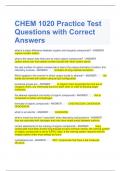
-
CHEM 1020 Practice Test Questions with Correct Answers
- Exam (elaborations) • 12 pages • 2024
- Available in package deal
-
- £7.58
- + learn more
CHEM 1020 Practice Test Questions with Correct Answers what is a major difference between organic and inorganic compounds? - ANSWER organic contain carbon what is the reason why there are so many organic compounds? - ANSWER carbon atoms can form stable covalent bonds with other carbon atoms the vast number of organic compounds is due to the unique chemistry of carbon. this chemistry involves - ANSWER formation of long chains& isomerism Which applies to the manner in which carbon bond...
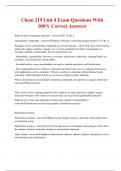
-
Chem 219 Unit 4 Exam Questions With 100% Correct Answers
- Exam (elaborations) • 15 pages • 2024
- Available in package deal
-
- £10.09
- + learn more
Chem 219 Unit 4 Exam Questions With 100% Correct Answers What are the four halogen elements? - answerF, Cl, Br, I organohalide compounds - answerOrganic molecules containing halogen atoms (F, Cl, Br, I) Examples of how organohalide compounds are used by humans - answer- have been found in marine life (algae, mollusks, sponges, etc.), bc they metabolize the high concentrations of inorganic chlorides and bromides that are found in the seas. - Industrially, organohalides find uses as solvent...



